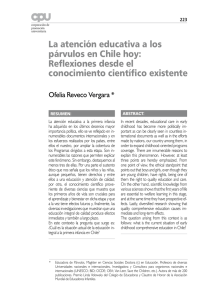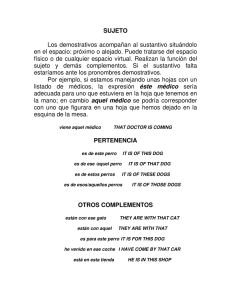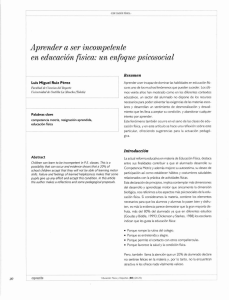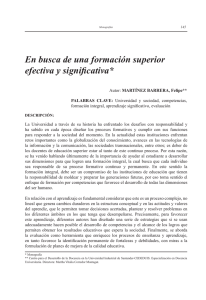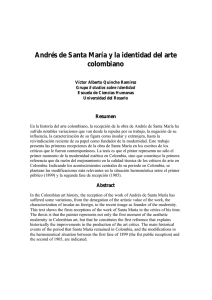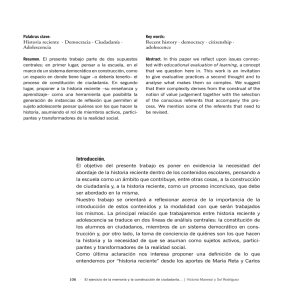yves hayat
Anuncio
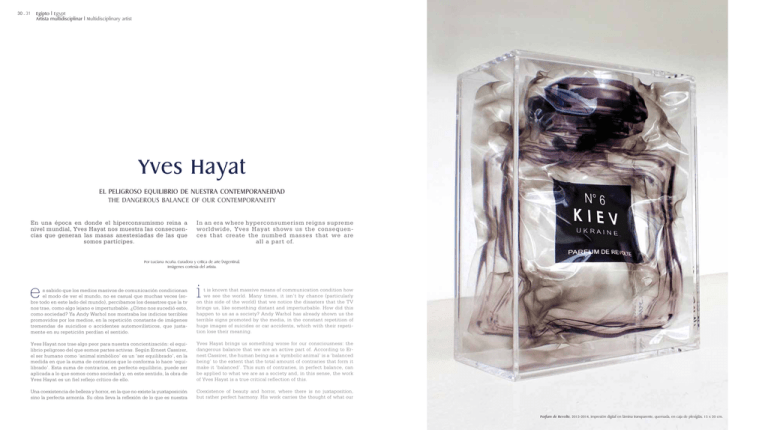
30 . 31 Egipto | Egypt Artista multidisciplinar | Multidisciplinary artist Yves Hayat El peligroso equilibrio de nuestra contemporaneidad The dangerous balance of our contemporaneity En una época en donde el hiperconsumismo reina a nivel mundial, Yves Hayat nos muestra las consecuencias que generan las masas anestesiadas de las que somos partícipes. In an era where hyperconsumerism reigns supreme worldwide, Yves Hayat shows us the consequences that create the numbed masses that we are all a par t of. Por Luciana Acuña. Curadora y crítica de arte (Argentina). Imágenes cortesía del artista. e i Yves Hayat nos trae algo peor para nuestra concientización: el equilibrio peligroso del que somos partes activas. Según Ernest Cassirer, el ser humano como ‘animal simbólico’ es un ‘ser equilibrado’, en la medida en que la suma de contrarios que lo conforma lo hace ‘equilibrado’. Esta suma de contrarios, en perfecto equilibrio, puede ser aplicada a lo que somos como sociedad y, en este sentido, la obra de Yves Hayat es un fiel reflejo crítico de ello. Yves Hayat brings us something worse for our consciousness: the dangerous balance that we are an active part of. According to Ernest Cassirer, the human being as a ‘symbolic animal’ is a ‘balanced being’ to the extent that the total amount of contraries that form it make it ‘balanced’. This sum of contraries, in perfect balance, can be applied to what we are as a society and, in this sense, the work of Yves Hayat is a true critical reflection of this. Una coexistencia de belleza y horror, en la que no existe la yuxtaposición sino la perfecta armonía. Su obra lleva la reflexión de lo que es nuestra Coexistence of beauty and horror, where there is no juxtaposition, but rather perfect harmony. His work carries the thought of what our s sabido que los medios masivos de comunicación condicionan el modo de ver el mundo, no es casual que muchas veces (sobre todo en este lado del mundo), percibamos los desastres que la tv nos trae, como algo lejano e imperturbable. ¿Cómo nos sucedió esto, como sociedad? Ya Andy Warhol nos mostraba los indicios terribles promovidos por los medios, en la repetición constante de imágenes tremendas de suicidios o accidentes automovilísticos, que justamente en su repetición perdían el sentido. t is known that massive means of communication condition how we see the world. Many times, it isn’t by chance (particularly on this side of the world) that we notice the disasters that the TV brings us, like something distant and imperturbable. How did this happen to us as a society? Andy Warhol has already shown us the terrible signs promoted by the media, in the constant repetition of huge images of suicides or car accidents, which with their repetition lose their meaning. Parfum de Revolte, 2013-2014, impresión digital en lámina transparente, quemada, en caja de plexiglás, 15 x 20 cm. existencia humana. Una perfecta sincronía entre creación preciosista y la más terrible destrucción: mientras en la cuna de la moda, se llevan a cabo prestigiosos desfiles de los más importantes diseñadores de alta costura, medio oriente se debate entre la supervivencia y la muerte. human existence is. It is a perfect synchronization between precious creation and the more terrible destruction: while in the heart of fashion they do prestigious fashion shows of the most important designers in high fashion, in the Middle East they struggle with survival and death. Yves Hayat nació en Egipto, pero el desarraigo de la primera revolución en su país lo llevó a los 10 años a vivir en Francia, pero en su patria ya había visto el daño generado por la guerra, la inseguridad y el éxodo, elementos fundamentales para la comprensión de su obra. Habiéndose formado en la Escuela Nacional Superior de Artes Decorativas de Niza, comienza sus primeras indagaciones de mano de la publicidad y el marketing, herramientas que más adelante van a ser de vital importancia a la hora de desarrollar su mirada crítica sobre la sociedad. Yves Hayat was born in Egypt, but the uprooting of the first revolution in his country took him to live in France for 10 years, but in his homeland he had already seen the damage caused by war, the insecurity and the exodus, which are basic elements to understand his work. Having been educated in the École Nationale Supérieure des Arts Décoratifs (National School of Decorational Arts) in Nice, he begins his first investigations through publicity and marketing, tools that would later be vital when developing his critical view on society. Desde el año 2001 se dedica exclusivamente al arte, indefinible, el término que utilizan los franceses para encasillarlo es Plasticien. Since 2001, he has only worked as an artist, indefinable, the term that the French use to categorize it is Plasticien. En entrevista exclusiva, pregunté sobre los opuestos en su obra, a lo que respondió: “La idea de confrontar dos opuestos como belleza/ horror, lujo/violencia, intolerancia/indiferencia. Me ha venido a partir de la vista, de una escena de la película Good Morning Vietnam. Gente asustada es enjuiciada y aterrorizada por soldados, la escena en sí es horrible, pero el director puso de fondo, la canción Louis Armstrong What a Wonderful World. Esta oposición amplifica el horror y deja lugar a la costumbre de que en última instancia nos hace apático a la profusión de imágenes de noticias”. In an exclusive interview, I asked about the opposition in his work, to which he responded: “The idea of confronting two opposites as beauty/horror, luxury/violence, and intolerance/indifference. I started from a scene from the movie Good Morning Vietnam. Scared people are put on trial and terrorized by soldiers, the scene itself is horrible, but the director put the song What a Wonderful World by Louis Armstrong in the background. This opposition amplifies the horror and that ultimately leaves room for the habit of making us apathetic to the profusion of news images. En su obra Parfum de Revolte (Perfume de Revuelta), se representa esta idea: “Inicialmente una imagen icónica de lujo, la belleza, la pureza: la botella de Chanel N º 5. Pero yo la transformo en algunos elementos: la marca blanca se vuelve negro, el texto se sustituye por los nombres de los lugares donde hay o hubo guerra, rebelión, violencia (Kiev, Homs, Teherán, Tiananmen ...), el subtítulo "El perfume reinado” se convierte en "Perfume de rebelión." La imagen se reproduce por triplicado, en películas transparentes para ser quemadas como en tiempos de guerra y luego encerradas en cajas de plexiglás transparente. Mi objetivo es hacer sentir cómo todo este lujo palidece frente a los desastres de la guerra, y también para llamar la atención a la voluntad colectiva de Occidente para imponer su sistema capitalista y su cultura en las culturas que son ajenas a él”. In his work Parfum de Revolte (Perfume of Revolt), this idea is represented: “Initially, an iconic image of luxury, beauty, purity: the bottle of Chanel No. 5. But I transform it in some elements: the white label becomes black, the text is replaced by names of places where there are or have been wars, rebellions, violence (Kiev, Homs, Teheran, Tiananmen…), the subtitle “The reigning perfume” becomes “The perfume of rebellion.” The image is reproduced three times, on transparent film to be burned like in times of war and later locked away in transparent Plexiglas boxes. My objective is to create the feeling that all of this luxury fades in face of the disasters of war, and also to draw attention to the collective willingness of the West to impose its capitalist system and its culture within the cultures that are foreign to it.” Les Icones Sont Fatiguees, 2011-2014, impresiónes C-color en láminas transparentes, quemadas, en cajas de plexiglás, 15 x 20 cm. En sus obras está presente un estudio pormenorizado de las imágenes, pero sobretodo del mensaje, es así como además de las imágenes icónicas del consumismo, también trabaja a partir de citas a la historia del arte. Es claro que para esto hace un profundo análisis de las miradas que constituyeron, a lo largo de la historia, una lectura de cada contemporaneidad que las vio nacer, para ello el mejor ejemplo lo representa su obra Inocencio X, Hayat en relación a ella comenta: “Los desastres y errores de la historia se dice que son una lección, pero al parecer nada impide que vuelva a ocurrir. Así que a menudo me enfrento al pasado y al presente. El mejor ejemplo es mi trabajo Inocencio X, que es una doble desviación entre el papa pintado por Velázquez y el otro presentado por Francis Bacon. Bacon lo hizo llorar detrás de una cortina y yo le he cerrado los ojos y le sustituí el telón con una cortina de bombas, para decir que el Papado a menudo ha tolerado muchas masacres bien, aunque tiende a cambiar en la actualidad. Una obra está ahí para cuestionar, para hacernos conscientes y hasta molestarnos, el riesgo sigue siendo la indiferencia y el lugar común”. In his work, there is a detailed study of the images, but above all, of the message. This is also how, in addition to the iconic images of consumerism, he works from quotes from the history of art. It is clear that for this, he carries out a deep analysis of the views that constructed, throughout history, a reading of each contemporaneity that it saw come into being. For that, the best example is represented in his work Inocencio X. In relation to that, Hayat comments: “The disasters and errors throughout history are said to be a lesson, but it seems nothing stops it from happening again. That is how I often face the past and present. The best example of this is my work Inocencio X, which is a double deviation between the pope painted by Velázquez and the other presented by Francis Bacon. Bacon made him cry behind a curtain and I have closed his eyes and replaced his cloth with a curtain of bombs, in order to say that the papacy has often tolerated many massacres well, although it tends to change in current times. A work of art is there to make us question things, to make us aware and to even offend us; the risk is still indifference and common grounds. En este mismo orden de búsqueda, Hayat tiene una serie denominada Mythificaction en la que trabaja a partir de imágenes de la historia del arte que se encuentran relacionadas con la religión cristiana. Hayat me detalla lo siguiente: “En este trabajo, opté por fotografiar la sencilla desnudez del cuerpo, un modelo en carne de acuerdo con la gran tradición de la pintura en las posiciones crísticas, incluidas en nuestra memoria colectiva. Respetando las posiciones codificadas de las pinturas de los grandes maestros (flagelación, crucifixión, descendimiento, piedad, santo entierro, resurrección…). He eliminado la decoración pomposa de estas obras. Traté de descubrir la sencillez y humildad de Cristo/el hombre solitario, aplastado, destrozado, condenado a muerte por nuestra violencia cotidiana y global. Frente a un espectador hecho insensible por demasiadas fotos e información, he tratado de expresar el sufrimiento en un universo oscuro…”. In this same line of research, Hayat has a series called Mythificaction in which he works from images from art history that are related to the Christian religion. Hayat tells me the following: “In this work, I opted to photograph the simple nudity of the body, a model in flesh according to the great tradition of painting in Christ-like positions, included in our collective memory. By respecting the encrypted positions of the painting of the great masters (flagellation, crucifixion, decent, piety, holy entombment, resurrection…), I have removed the pompous decoration of these works. I tried to discover the simplicity and humility of Christ/the lonely man, crushed, destroyed, condemned to death by our global and daily violence. In front of a viewer made insensitive by an abundance of pictures and information, I have tried to express the suffering in a dark universe…”. El espectador que contemple las obras de Hayat debe estar abierto a percibir la realidad desde otra perspectiva, la real. Para aquellos anestesiados e inconmovibles, que pertenecen a las mayorías silenciosas, la obra de Hayat es una buena oportunidad para abrir los ojos y la mente. Estará en cada uno de ellos el continuar con una vida apática, o comenzar a tomar las riendas de las acciones que pueden cambiar al mundo. The viewer that looks at Hayat’s work must be open to see reality from another perspective, the real one. For those who are numb and unmoved, who belong to the quieter majority, Hayat’s work is a good opportunity for them to open their eyes and mind. It will be up to each person to continue with an apathetic life, or to start to take control of the actions that could change the world. Idees Noires, 2013, impresión C-color en lámina transparente, quemada, en caja de plexiglás, 40 x 30 x 10 cm.
